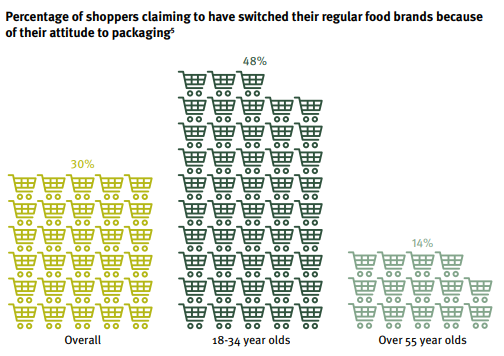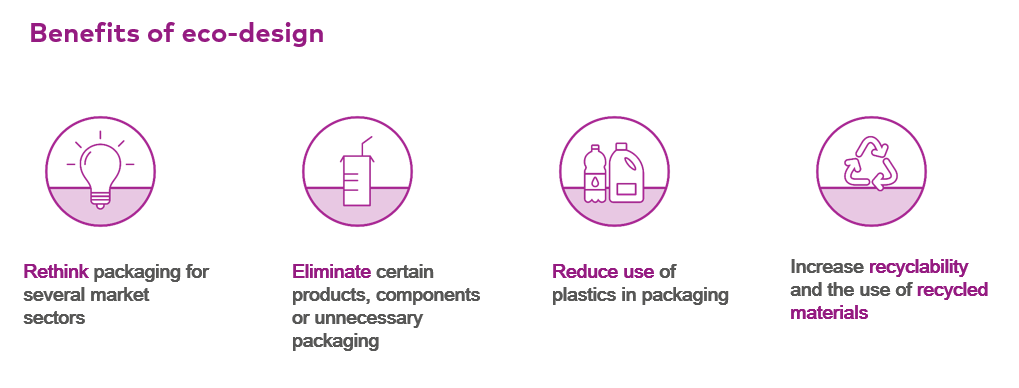Packaging during the pandemic: 5 key questions to envision the future
Geneviève Dionne, Director, Ecodesign and Circular Economy
The recycling industry crisis, the scale of environmental issues and the dramatic increase in public pressure over the past few years have all pushed companies to take action regarding their packaging.
The issues generated a plethora of eco-responsible practices and initiatives, particularly for everyday consumer goods such as food products.
However, in early 2020, with the worldwide pandemic caused by COVID-19, projects and initiatives were rapidly disrupted or slowed in their tracks.

Since then, the health crisis has drastically changed consumer habits and the concerns it creates for consumers and companies alike are numerous.


Effects and repercussions of the health crisis on behaviours
- Perception and feeling of vulnerability
- Health and safety apprehension with regard to hygiene
- Upturned habits and values
- Initiatives to reduce single-use packaging have been put on hold
What types of behaviours does this create regarding packaging?
According to recent data published by the Observatoire de la consommation responsable, more than half of Quebecers who used bulk products before the crisis have stopped doing so. The same trend was observed regarding the use of reusable plastic bags, which 17% of Canadians consider to be unhealthy.[1]
With the pandemic, people no longer wonder whether packaging still has its place or why it hasn’t been eliminated for environmental reasons. They are now realizing the essential functions packaging plays regarding issues of health and safety: hygiene and cleanliness. That being said, to make the best possible choices, companies and consumers must be well supported.
Will this crisis have long-term effects on our habits as consumers?
We’ve already seen that the demand for packaged and portioned products has gone up as has the use of plastic. As for online purchases, they have simply skyrocketed, which means a sharp increase in packaging for home deliveries. According to a survey conducted by Léger and lg2, 78% of Canadians say they want to continue using the online services they used during the crisis.[2]
The obsolescence of primary packaging
Primary packaging is designed to be used for retail sales. This is the packaging that consumers interact with, and that’s why so much attention goes into its design. It has to stand out, be attractive and informative to consumers. It is expected to offer good visibility, push the sale and enable consumers to carry it until it is used.
For online business, however, most of those sales features are handled by the online sales platform, and primary packaging is much less essential; in some cases, it can even be obsolete, especially in the case of non-perishable items.
Will the pandemic push us to rethink our production and consumption models?
As the pandemic is in part the result of globalisation and interdependence of economic markets, the answer is unequivocally Yes. Market globalisation, which generates shortages of products and raw materials as well as production and delivery delays, is pushing governments and industries to push local business to the forefront.There is a good chance this reality will be supported by Canadians, as 99% of them who purchased local products for the first time since the beginning of the crisis say they want to continue doing so.[3]
Will this pandemic move us further from out goals to reduce single-use and plastic packaging?
For sure, the pandemic has shaken us to the core and made us realize the issues regarding health and safety. Since the start of the crisis, the production of single-use bags has gone up 20%[4] and plastic is found in high-demand products such as gloves, masks, face shields and take-out food containers. However, it goes without saying that eco-responsible efforts aiming to reduce our environmental footprint must continue; it is totally possible to produce eco-designed packaging that also fulfills its primary functions.
Is it possible to combine our environmental ambitions and adequate safety measures?
It’s still too soon to tell. One thing is certain, though: the exceptional situation we are going through is a catalyst for us to work together more than ever towards finding eco-responsible, collaborative, sustainable and safe solutions that help make a difference. Additionally, we can imagine that concepts like traceability and transparency along the entire supply chain will become a leitmotiv for more and more companies.
This is an opportunity to rethink how we produce and consume, and to make packaging ecodesign the norm!

[1] Source : https://ocresponsable.com/wp-content/uploads/2020/05/Vigie_Conso_COVID-19_Mensuelle01.pdf
[2] Source : www.bonvisionnement.net/lg2xleger/reimaginer-votre-marque-pendant-la-crise
[3] Source : www.bonvisionnement.net/lg2xleger/reimaginer-votre-marque-pendant-la-crise
[4] Source : https://ocresponsable.com/wp-content/uploads/2020/05/Vigie_Conso_COVID-19_Mensuelle01.pdf